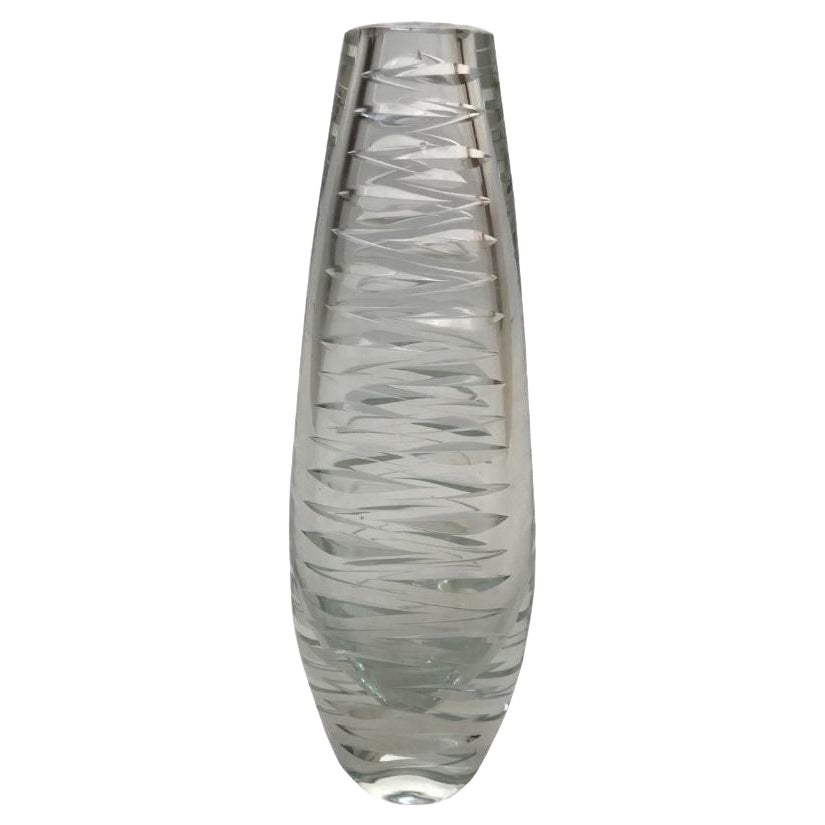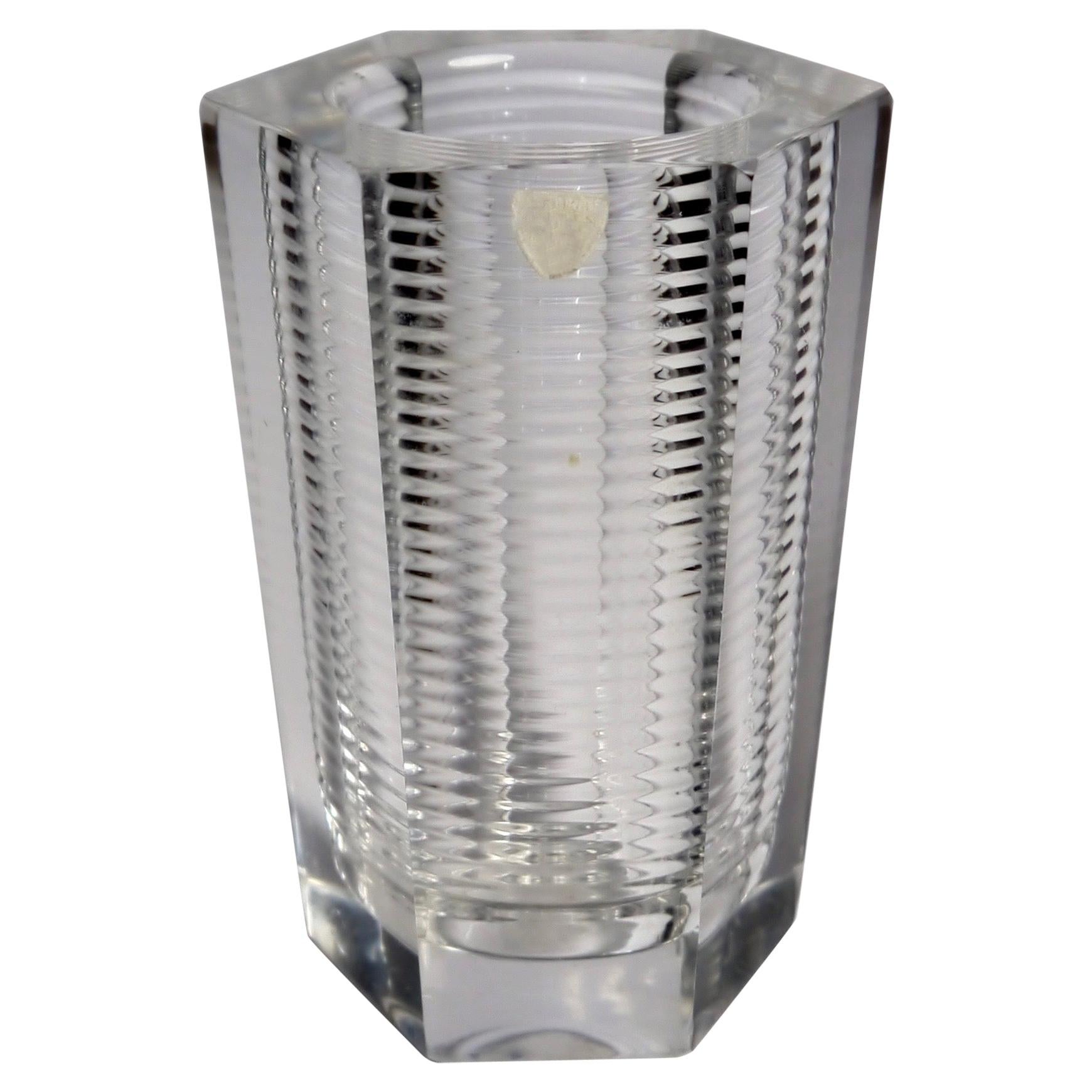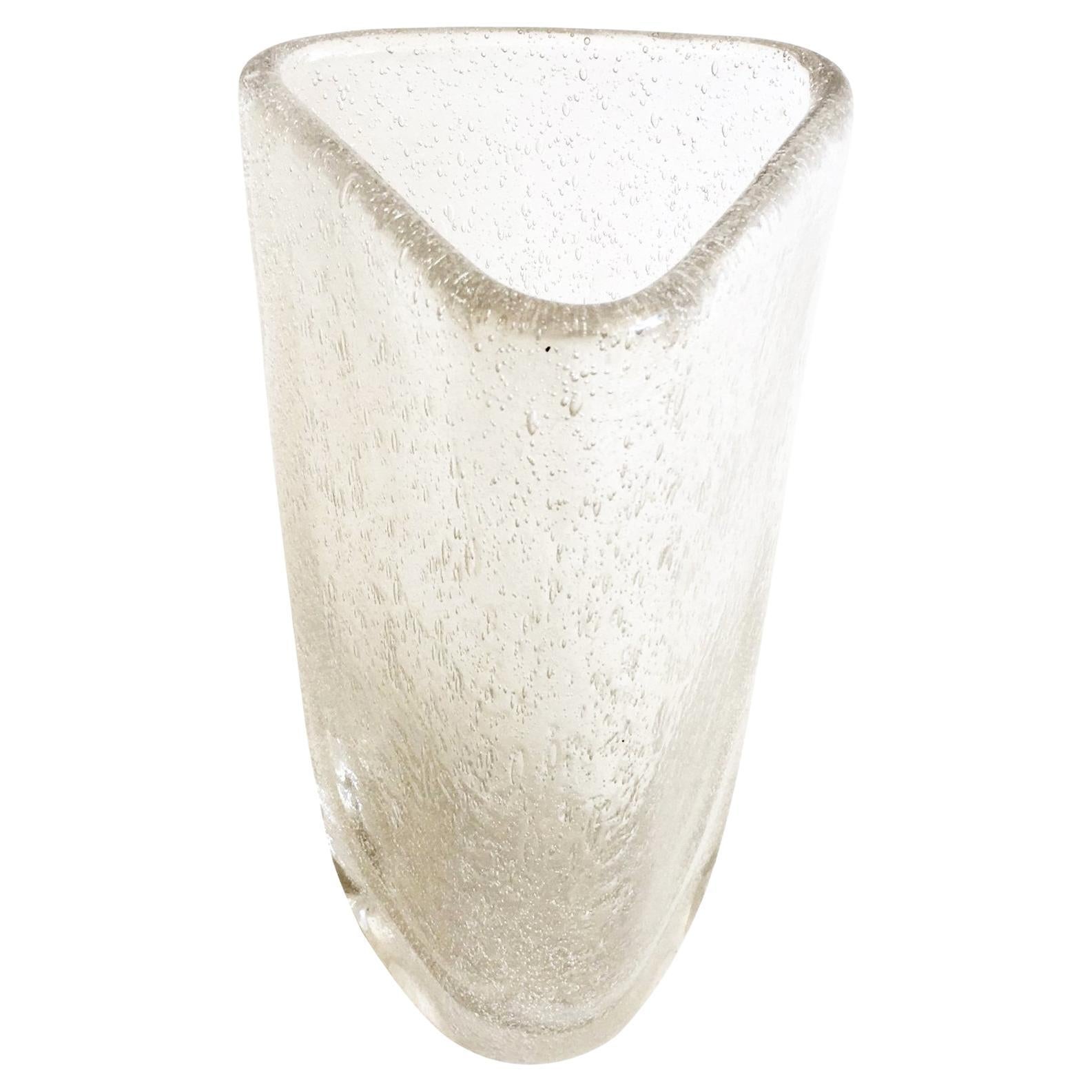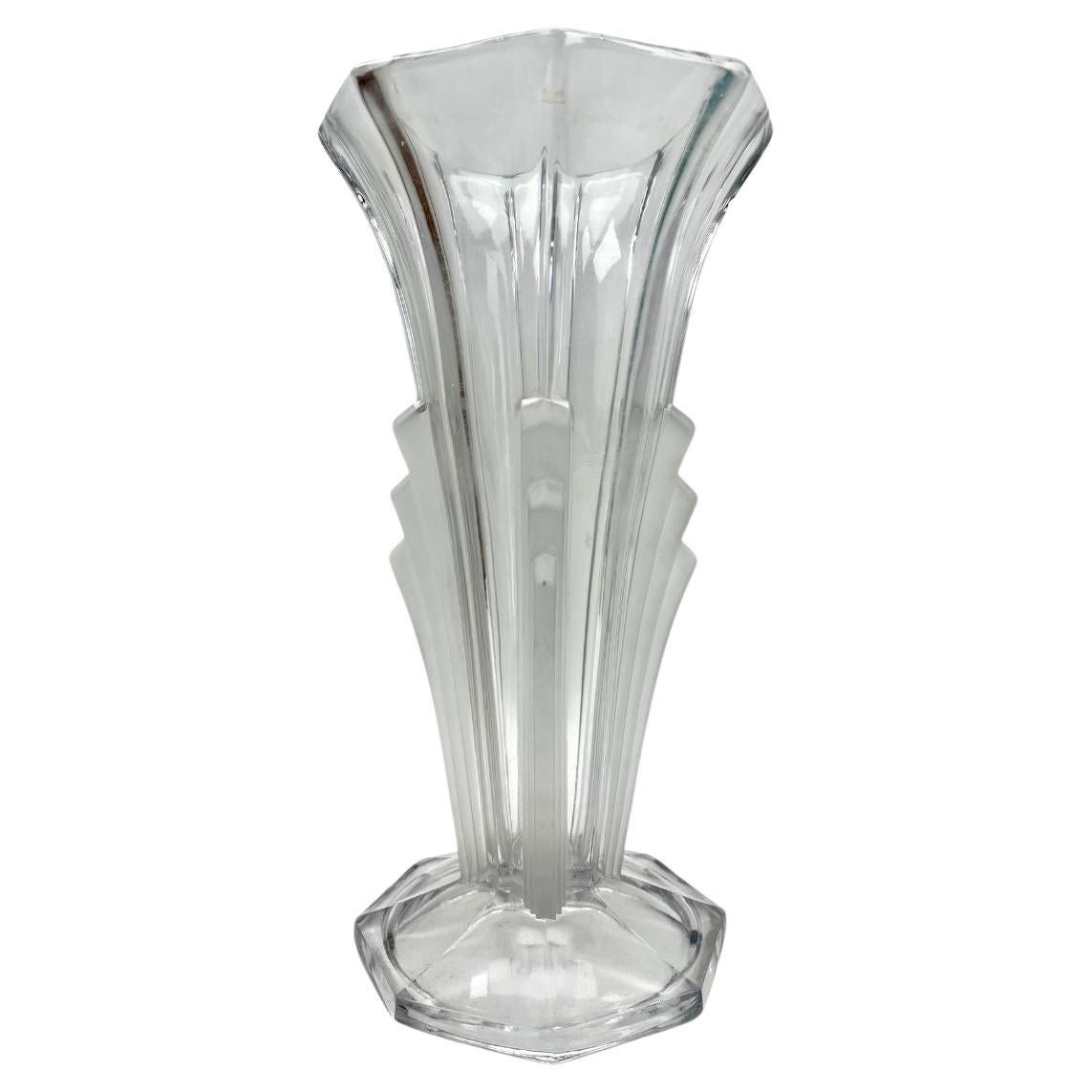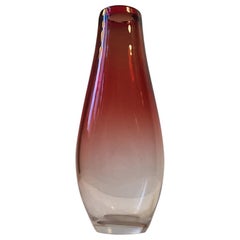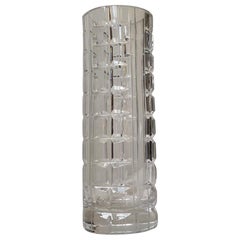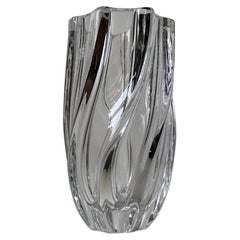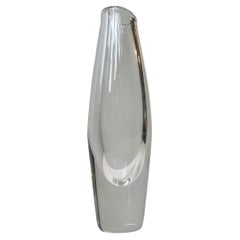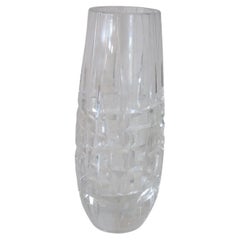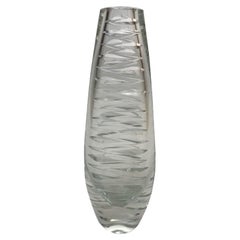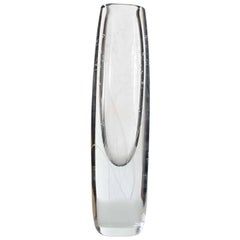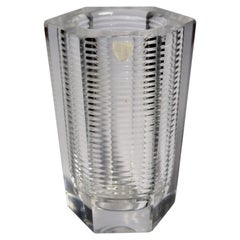Items Similar to Scandinavian Glass Vase with Arrows, 1930s
Want more images or videos?
Request additional images or videos from the seller
1 of 5
Scandinavian Glass Vase with Arrows, 1930s
$208.97
$278.6325% Off
£155.95
£207.9425% Off
€176.25
€23525% Off
CA$291.76
CA$389.0225% Off
A$318.22
A$424.2925% Off
CHF 167.31
CHF 223.0825% Off
MX$3,849.40
MX$5,132.5325% Off
NOK 2,087.77
NOK 2,783.7025% Off
SEK 1,972.75
SEK 2,630.3325% Off
DKK 1,342.16
DKK 1,789.5425% Off
About the Item
A cast glass vase decorated with arrow motifs. Made in Denmark during the 1930s, probably by Lyngby Glas. The style of this piece mimics the industrial tendencies of Art Deco and the German Bauhaus movement in particular.
- Dimensions:Height: 7.88 in (20 cm)Diameter: 3.55 in (9 cm)
- Style:Bauhaus (Of the Period)
- Materials and Techniques:
- Place of Origin:
- Period:
- Date of Manufacture:1930s
- Condition:Well kept and intact antique condition.
- Seller Location:Esbjerg, DK
- Reference Number:1stDibs: LU1782223161352
About the Seller
4.9
Platinum Seller
Premium sellers with a 4.7+ rating and 24-hour response times
Established in 2010
1stDibs seller since 2016
1,407 sales on 1stDibs
Typical response time: 1 hour
- ShippingRetrieving quote...Shipping from: Esbjerg, Denmark
- Return Policy
Authenticity Guarantee
In the unlikely event there’s an issue with an item’s authenticity, contact us within 1 year for a full refund. DetailsMoney-Back Guarantee
If your item is not as described, is damaged in transit, or does not arrive, contact us within 7 days for a full refund. Details24-Hour Cancellation
You have a 24-hour grace period in which to reconsider your purchase, with no questions asked.Vetted Professional Sellers
Our world-class sellers must adhere to strict standards for service and quality, maintaining the integrity of our listings.Price-Match Guarantee
If you find that a seller listed the same item for a lower price elsewhere, we’ll match it.Trusted Global Delivery
Our best-in-class carrier network provides specialized shipping options worldwide, including custom delivery.More From This Seller
View AllMidcentury Glass Vase by Nils Landberg for Orrefors, 1950s
By Orrefors
Located in Esbjerg, DK
This red and clear glass vase was designed by Nils Landberg in the mid-1950s and manufactured by Orrefors in Sweden. Due to wear, the signatur...
Category
Vintage 1950s Swedish Mid-Century Modern Vases
Materials
Blown Glass
$374 Sale Price
20% Off
Scandinavian Modern Cut Crystal Vase, 1950s
Located in Esbjerg, DK
A cut crystal torpedo shaped vase presumably from either Kosta Boda or Orrefors. It features diffrent techniques most prominent the mix of vertical ribbings and geometric patterns. I...
Category
Vintage 1950s Scandinavian Scandinavian Modern Vases
Materials
Crystal
$222 Sale Price
25% Off
Twisted Art Glass Vase by Anna Ehrner for Kosta Boda, 1980s
By Kosta Boda
Located in Esbjerg, DK
A twisted art glass vase called Royal. It was designed by Anna Ehrner in the early 1980s and manufactured by Kosta Boda in Sweden. Its signed/et...
Category
Vintage 1980s Swedish Scandinavian Modern Vases
Materials
Art Glass
$262 Sale Price
25% Off
Swedish Modern Torpedo Crystal Vase by Sven Palmqvist for Orrefors, 1950s
By Sven Palmquist
Located in Esbjerg, DK
Thick organically shaped art glass vase. Designed by Sven Palmqvist and made at Orrefors in Sweden during the 1950s. Fine, clean and intact vintage order. Hand-signed/numbered beneat...
Category
Mid-20th Century Swedish Scandinavian Modern Vases
Materials
Crystal
Scandinavian Sommerso Glass Vase by Josef Schott for Smålandshyttan, 1960s
By Smålandshyttan
Located in Esbjerg, DK
Lean hand blown glass vase with caramel brown Sommerso/hues. Designed by Josef Schott and manufactured by Smålandshyttan in Sweden during the 1960s It still has its original paper st...
Category
Vintage 1960s Swedish Scandinavian Modern Vases
Materials
Blown Glass
$177 Sale Price
25% Off
French Art Deco Cut Crystal Vase in the style of Daum, 1930s
By Daum
Located in Esbjerg, DK
Strictly cut rectangular cristal vase - vastly faceted vertically. Unknown French maker in the style of Daum. No markings. It measures 26.5 cm in height and has a top-width 8x8 cm. I...
Category
Vintage 1930s French Art Deco Vases
Materials
Crystal
$333 Sale Price
25% Off
You May Also Like
20th Century Italian Design Art Glass Vase, 1970s
Located in Casale Monferrato, IT
Beautiful large Italian desgn vase in the style of Barovier. Art glass with particular engraved processing.
Category
Vintage 1970s Italian Crystal Serveware
Materials
Art Glass
$948 Sale Price
20% Off
Vase in Crystal, 1950, France
Located in Ciudad Autónoma Buenos Aires, C
Crystal.
We have specialized in the sale of Art Deco and Art Nouveau and Vintage styles since 1982.
Why are there so many antiques in Argentina?
In the 1880 – 1940 there was a grate wave of immigration encouraged by the periods of war that were taking place.
1st World War took place between 1914 and 1918
2nd World War took place between 1939 and 1945
The immigrants options were New York or Buenos Aires. Tickets were cheap and in Buenos Aires they were welcomed with open arms, as it was a country where everything was still to be done.
Argentina was the country of new opportunities, labour was needed and religious freedom was assured, in many cases the of the family travel first until they were settled and then the rest of the family members join them.
In the immigrant museum “Ellis Island Immigrant Building” in New York you can se the promotional posters of the boats that would take them to a new life.
Between the years 1895 and 1896, Argentina had the highest DGP (gross domestic product) per capita in the world according to the Maddison Historical Statistics index, this situation arose due to the large amount of food being exported to European countries, which were at war.
The Argentinean ships left the port of Buenos Aires with food, but they returned with furniture, clothes and construction elements, (it´s common to see this the old buildings of the historic neighbourhood of San Telmo, the beams with the inscription “Made in England)”, as well as many markets that were built in Buenos Aires, such us the San Telmo Market, whose structure was brought by ship and afterwards assembled in 900 Defensa Street.
With the great influence of European immigrants living in the country, the children of the upper classes travelled to study in France, resulting in the inauguration of “La Maison Argentinienne”, on 27th of June 1928, in the international city of Paris, which hosted many Argentinians that were studying in Frace.
It´s the fourth house to be built after France, Canada and Belgium, being the first Spanish-speaking one. Still in place today (17 Bd Jourdan, 75014, Paris, France). Many of the children of these wealthy families who attended international art exhibitions, museums and art courses abroad, took a keen interest in the European style. This is why Buenos Aires was at the time referred as “The Paris of South America”.
Between the years 1890 and 1920 more than a hundred Palaces were built on Alvear Avenue the most exclusive avenue in Buenos Aires. Today some of these palaces have been transformed into museums, hotels and embassies.
In the year 1936, the Kavanagh building was inaugurated, it was the tallest reinforced concrete building in South America.
During 1994 the American Society of Civil Engineers distinguished it as an “international engineering milestone”, and it´s now considered a World Heritage of Modern Architecture.
At the time was common to hire foreign architects such as Le Corbusier, who visited Buenos Aires/Argentina in 1929 and in 1948 he drew up the blueprints for a house built in La Plata City (which was declared a World Heritage Site).
In 1947, the Hungarian architect Marcelo Breuer designed “Parador Ariston” in the seaside city of Mar del Plata. After an Argentinean student at Harvard University convinced him to come to Argentina. He worked on an urban development project in the Casa Amarilla, area of La Boca.
The Ukrainian architect, Vladimiro Acosta, arrives in Argentina in 1928 and worked as an architect until que moved to Brazil.
Antonio Bonet, a Spanish architect who worked with Le Corbusier in Paris, arrives in Argentina in 1937, where he carried out several architectural works and in 1938 designs the well-known BFK chair.
Andres Kálnay, of Hungarian origin, made around 120 architectural masterpieces, among which the former Munich brewery stands out, he even made the furniture’s design.
The German architect, Walter Gropius, director of the Bauhaus, lived in Argentina, where he wrote articles for “Sur” magazine and founded in Buenos Aires, an architectural firm with Franz Möller, who was also an architect, where he built two houses.
At the same time several famous designers decided to immigrate to Argentina, among them we can find the well-known French designer, Jean-Michel Frank, who arrived in the country in 1940 and also worked for the Rockefeller family.
Special pieces were made, which were sold exclusively in the country, such as the well-known German company “WMF”, who sold their products by catalogue, which were chosen by the ladies of High Society in the list of wedding gifts, as well as the pieces designed by Christofle.
The Swiss sculptor Alberto Giacometti, made special pieces for Argentinean mansions.
In 1904 the first Jansen branch outside Paris was established in Buenos Aires, as the Argentinean clientele demanded a large amount of furniture, from the end of the 19th century to the Mid-20th Century.
In 1970, the brand Rigolleau Argentina made pieces authorised by Lalique.
The brands Maple and Thompson also set up shop in the country.
The French plastic artist, Marcel Duchamp moved to Argentina in 1918-1919.
Glass signed Gallé, Charder, Leverre, Schneider, Muller and other French firms. They were bought in flower shops and were given to ladies with beautiful floral arrangements.
Some furniture manufacturers travelled to international fairs and bough the patterns to produce the furniture in Argentina, such as the furniture firm Englander and Bonta, who bought the patterns ins Italy.
It is worth mentioning that in Argentina we have the largest Community of Italians outside...
Category
Vintage 1940s French Art Deco Vases
Materials
Crystal
Scandinavian Mid-Century Art Glass Bud Vase
Located in Queens, NY
Scandinavian Mid-Century tall ovoid art glass bud vase with etched floral design (signed)
Category
20th Century Scandinavian Mid-Century Modern Vases
Materials
Glass
Scandinavian Modern Glass Vase by Orrefors, 1930s
By Orrefors
Located in Barcelona, ES
Glass vase produced at Orrefors in 1930s. Stamp, somewhat torn, and marked "Orrefors" "1932".
Category
Early 20th Century Swedish Scandinavian Modern Glass
Materials
Glass
Art Deco Triangular Modernist Schneider Heavy Clear Glass Vase, Signed
By Charles Schneider
Located in London, Fitzrovia
Art Deco heavy triangular Schneider thick art glass vase with etched signature. clear glass, beautiful modernist shape.
Category
20th Century French Mid-Century Modern Vases
Materials
Art Glass
Art Deco Moulded glass vase, Czechoslovakia 1930s
Located in Verviers, BE
Art Deco Moulded glass vase, Czechoslovakia 1930s
Art Deco molded-glass vase from the 1930s
A superb, well-made molded-glass vase produced in Czechoslo...
Category
Vintage 1930s Czech Art Deco Glass
Materials
Art Glass
More Ways To Browse
Denmark Glass Vase
Brown Cameo
Brown White Vase
Three Vases Vessels
Vintage Green Glass
Arts And Crafts Black Vase
Brown Marble Vase
Bitossi Blue
Vintage Glazed Pottery
Apple White
Iittala Glasses
Mid Century Hand Thrown Pottery
Murano Glass Vase With Bubbles
Pair Cloisonne
Tall Blue And White Vase
Antique Japanese Pottery
Antique Number Stamps
Art Deco Bedroom Set 1920

